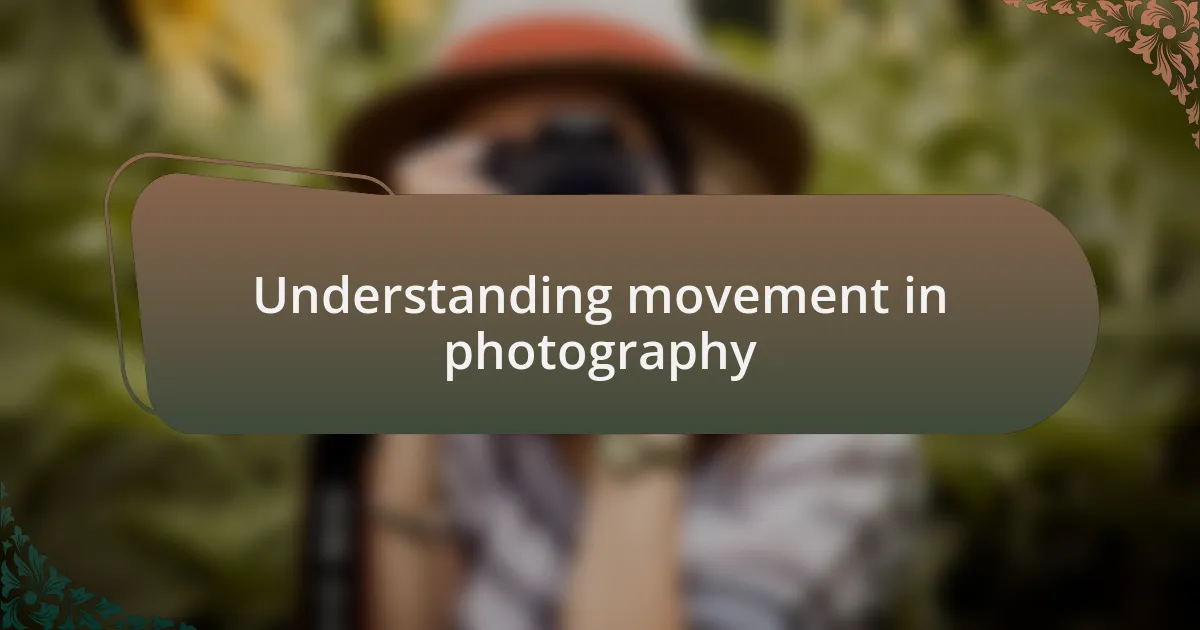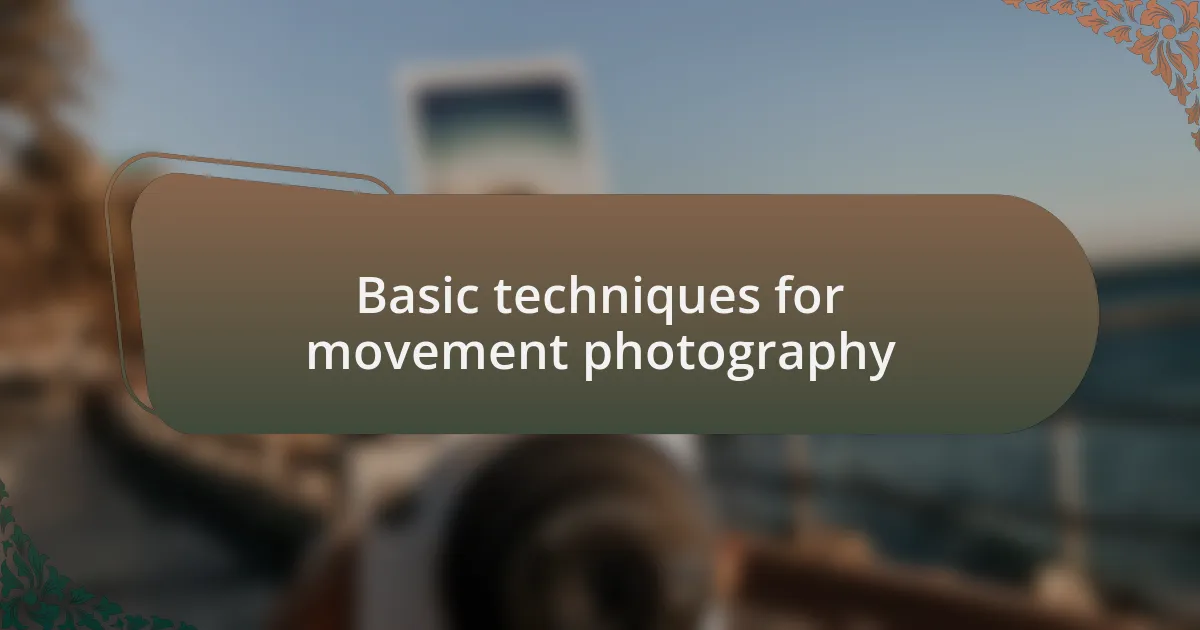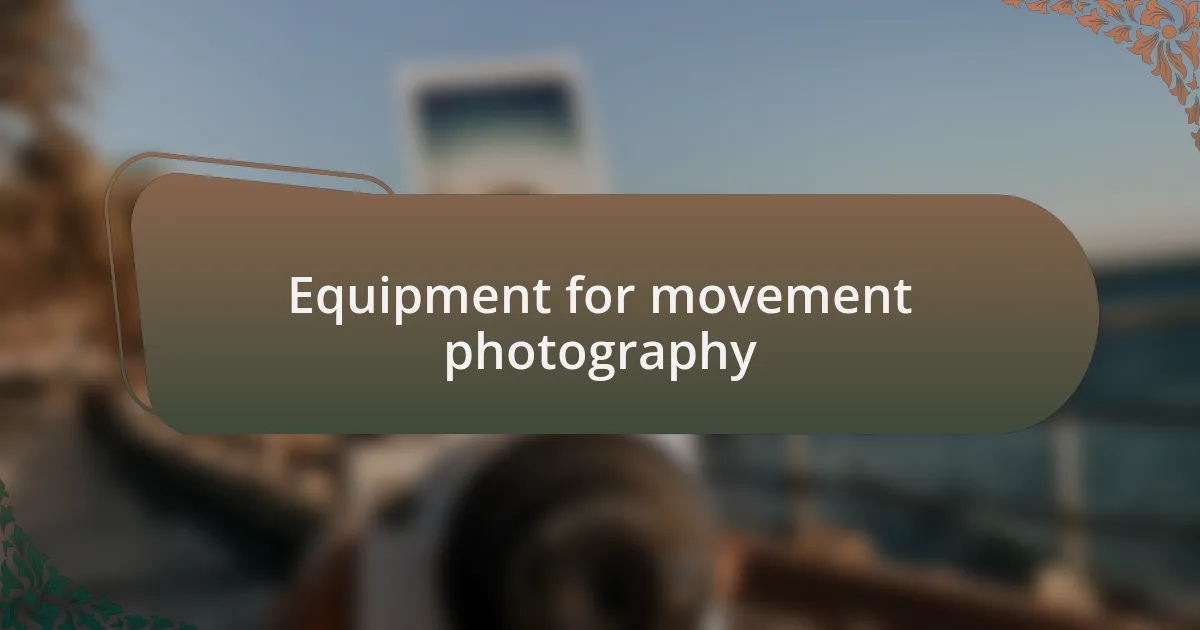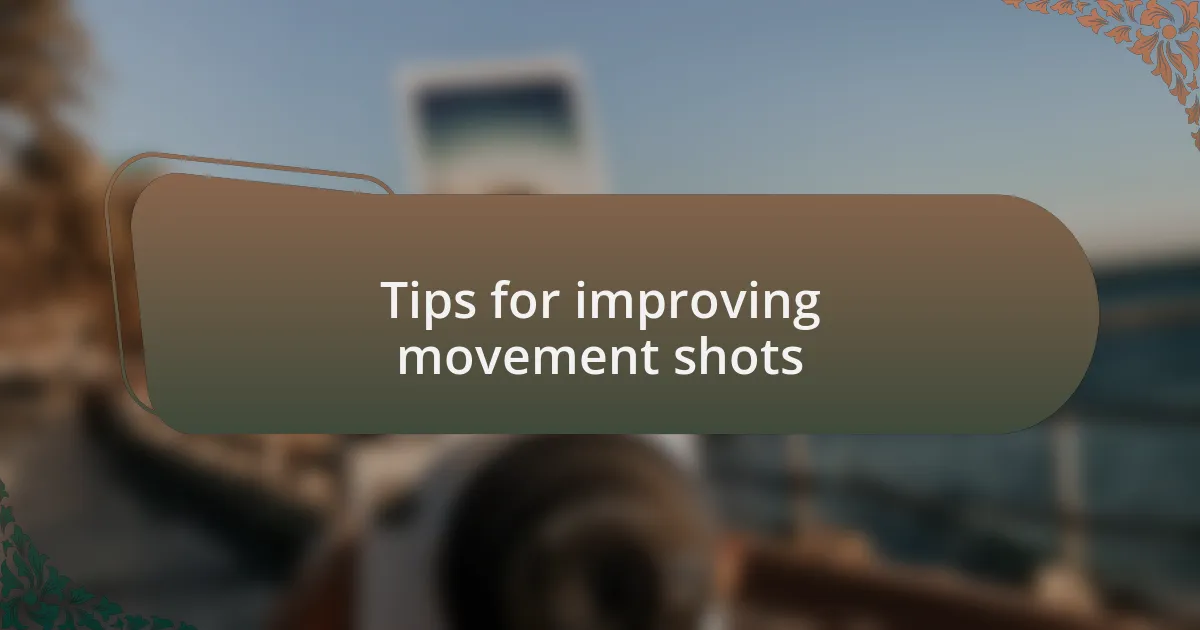Key takeaways:
- Understanding movement in photography enhances emotional connections and conveys dynamism, allowing viewers to feel the essence of a moment.
- Capturing movement involves techniques such as adjusting shutter speed, panning, and using motion blur to create impactful, dynamic imagery.
- The right equipment, including fast autofocus systems and ND filters, is crucial for effectively capturing movement in various lighting conditions.
- Improving movement shots requires timing, experimentation with settings, and strategic composition to enhance drama and storytelling in photographs.

Understanding movement in photography
Understanding movement in photography involves more than just capturing a subject in action; it’s about conveying a sense of momentum and emotion. I remember my first attempt at photographing a racing bike; I struggled to keep the focus sharp while trying to convey speed. It made me realize how essential timing is—those fleeting moments are what infuse a still image with life.
Movement can alter the emotional tone of a photograph. Have you ever felt a rush when viewing an image of a dancer mid-leap, their form frozen in time? This juxtaposition between stillness and dynamism evokes an adrenaline rush that keeps the viewer engaged. In my own work, I often experiment with blurring backgrounds while keeping my subject sharp, creating this contrast that speaks volumes about the action taking place.
It’s also fascinating to consider how different techniques, like panning or using slower shutter speeds, can dramatically affect the viewer’s experience. I recall capturing a sunset with boats peacefully drifting by; the gentle blur of the water added an element of serenity that felt almost tangible. How do you want your audience to feel when they look at your images? Understanding movement can guide you in creating photographs that resonate on an emotional level.

Importance of capturing movement
Capturing movement in photography is crucial because it breathes life into our images. I remember seeing a photograph of a child running with a kite, and the sheer joy radiating from the image was palpable. It made me think: how can one still frame evoke such energy? The answer lies in the ability to freeze time while showcasing that fleeting sense of freedom and adventure.
This art form goes beyond mere aesthetics; it serves as a narrative tool. I often reflect on the images I take at sporting events. The intensity of an athlete in motion, the camaraderie of a team celebrating a goal—these moments tell a story that static images simply can’t convey. Have you ever viewed a picture that made your heart race just from the movement captured in it? That’s the power of dynamic imagery.
Furthermore, different techniques for capturing movement enhance emotional connections. For instance, when I used a slower shutter speed to photograph a waterfall, it transformed the scene into a dreamy, almost mystical place. How does that soft blur change the way we perceive the scene? It invites viewers to not just see but also feel the essence of the moment, making the experience more immersive.

Basic techniques for movement photography
To effectively capture movement, one of the fundamental techniques I rely on is adjusting my shutter speed. When I photograph fast-moving subjects, like birds in flight, I often set my shutter speed to 1/1000 of a second. This crisp duration freezes the action, allowing me to observe the intricate details of feathers and expressions. Can you imagine the feeling of seeing a moment that was once fleeting now perfectly held in time?
Another approach I frequently adopt is panning, where I move my camera in sync with a subject in motion. I recall a moment at a local motorcycle race when I experimented with this technique. My camera followed the speeding bikes while using a slower shutter speed, resulting in a sharp rider against a beautifully blurred background. It’s exhilarating to capture that sense of velocity—it feels like the bike is racing right off the frame.
Finally, letting motion blur play into my compositions has its own charm. I remember standing at a busy intersection, where the cyclists sped past me as I adjusted my settings for a longer exposure. The blurred wheels and stretched lights painted a vivid scene that captured the city’s heartbeat. How does that blur affect your perception of the moment? For me, it invokes a feeling of dynamic energy, painting life with each stroke of movement.

Equipment for movement photography
When it comes to photography equipment for capturing movement, choosing the right camera and lens is essential. I often reach for my DSLR because it handles quick bursts of shots with ease. A fast autofocus system makes all the difference, especially in dynamic settings like sports or wildlife photography. Isn’t it fascinating how the right gear can elevate your ability to seize those fleeting moments?
Tripods can also be incredibly useful, particularly when you want to stabilize your camera during long exposures. I recall using a sturdy tripod while photographing dancers in an urban setting. It allowed me to combine slow shutter speeds with panning techniques without the fear of camera shake. Have you ever considered how a simple piece of equipment could unlock new creative possibilities for you?
Don’t overlook additional accessories like ND (Neutral Density) filters, which can be game-changers. They let me reduce the amount of light entering the lens, enabling longer exposures in bright conditions. I remember capturing the gentle motion of waves on a sunny afternoon. The ND filter helped me create that soft, silky effect that wouldn’t have been possible otherwise. How cool is it to manipulate light in such a way that you can transform the ordinary into something breathtaking?

Tips for improving movement shots
When it comes to improving movement shots, timing your shutter release is crucial. I’ve found that anticipating the action often yields the best results. For instance, while photographing a bird in flight, I’ve learned to watch for subtle cues in its posture, which signal its next move. Have you ever felt the rush of excitement just before capturing that perfect moment?
Another valuable technique is experimenting with shutter speed. In my experience, varying the shutter speed can drastically change the perception of movement in an image. On one occasion, I tried using a much slower shutter speed while shooting cyclists racing past me, resulting in a stunning blur that conveyed their speed and energy. How often do we realize that adjusting one setting can take our shots from ordinary to extraordinary?
Lastly, don’t forget about the power of composition in movement photography. I often use leading lines or dynamic angles to guide the viewer’s eye through the action. I remember photographing a skateboarder at a skate park; by positioning myself at a lower angle, I was able to emphasize the height of his jump and the thrill of the moment. Isn’t it amazing how a strategic choice in composition can enhance the drama of movement?

Personal techniques I use
When it comes to capturing movement, I often utilize burst mode on my camera. This technique allows me to take several shots in quick succession, which is invaluable when photographing fast-paced events, like a soccer game. I remember the adrenaline rush I felt while shooting my friend’s team; the thrill of capturing the perfect goal celebration was worth every click.
Another technique I rely on is panning, where I move my camera in sync with the subject. It’s a skill that requires practice, but the payoff is beautiful motion-blur backgrounds that make the subject pop. I recall trying this while photographing a dancer in motion; the result was a striking image that conveyed not just their movement but also the energy of the entire performance. Have you ever felt a sense of connection through such a dynamic composition?
Lastly, I often play with framing and perspective to capture unique angles of movement. I remember an exhilarating moment shooting a marathon; instead of capturing runners from the sidelines, I decided to position myself on a bridge. The view allowed me to capture them from above, showcasing the rhythm of their strides against the city backdrop. Isn’t it fascinating how a different vantage point can change the narrative of a movement shot entirely?